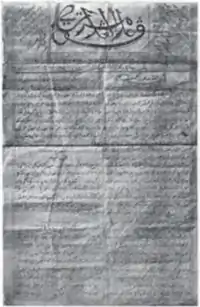Alamat Langkapuri
Alamat Lankapuri (Malay: علامت لڠكڤوري, 'News from the Island of Lanka') was a Malay language fortnightly publication in Jawi script, issued from Colombo, Ceylon.[1][2][3] Alamat Lankapuri was first published in June 1869.[1][2][4] It was the first Jawi script Malay-language newspaper printed worldwide.[1][5][6][7][8][9] The newspaper was printed by lithograph.[10]
 Cover of Alamat Langkapuri | |
| Type | Fortnightly |
|---|---|
| Publisher | Baba Ounus Saldin |
| Founded | 1869 |
| Language | Malay language |
| Ceased publication | 1878 |
| Headquarters | Colombo |
Baba Ounus Saldin was the publisher, editor and lithographer of Alamat Lankapuri.[3][11] Saldin set up a printing press by the name of Alamat Langkapuri Press, which gained fame in the Muslim community of the island (which printed Muslim Malay and Arabu-Tamil literature).[3][12]
The publication carried local and world news, as well as syairs, pantuns and other forms of traditional poetry.[13] Whilst primarily directed towards the Malay diaspora in Ceylon, the Alamat Langkapuri also had a readership in the Malay archipelago.[13] Through the newspaper Saldin sought to promote Malay culture and language. He published various advertisements for imports of Malay literature in Alamat Lankapuri, as well as advertisements for books to learn Malay and Malay-English dictionaries.[12] Some of the notices and advertisements in the newspaper were written in Arabu-Tamil.[14]
The publishing of Alamat Lankapuri was not a profitable venue for Saldin's private finances.[12] It was closed down towards the end of 1870, due to an insufficient number of subscribers.[3][15] The publication was relaunched in 1877, but closed down definitely in the following year.[2][3] Saldin started a new publication, Wajah Selong ('Light of Ceylon'), in 1895.[11] Alamat Lankapuri and Wajah Selong were the only two papers of their kind in the history of the country.[16]
References
- Universiti Kebangsaan Malaysia. Dunia Melayu. Kuala Lumpur: Universiti Kebangsaan Malaysia, 1986. pp. 121, 129
- Hussein, Asiff. Sarandib: An Ethnological Study of the Muslims of Sri Lanka. [Nugegoda]: Asiff Hussein, 2007. p. 421
- Kularatne, Tilak. History of Printing and Publishing in Ceylon, 1736–1912. Dehiwala: Tilak Kularatne, 2006. p. 205
- Thomas, Phillip Lee, and Bob Reece. Hikayat Panglima Nikosa = The Story of Panglima Nikosa. Kuching, Sarawak: Persatuan Kesusasteraan Sarawak, 1983. p. 2
- De Silva, R. K. 19th Century Newspaper Engravings of Ceylon-Sri Lanka: Accompanied by Original Texts with Notes and Comments. London: Serendib Publications, 1998. p. 6
- Deumert, Ana. Structure and Variation in Language Contact. Amsterdam [u.a.]: Benjamins, 2006.
- British Library. EAP450: Manuscripts of the Sri Lankan Malays Archived 2015-05-18 at the Wayback Machine
- Ricci, Ronit. The world's first Malay newspaper, Colombo, 1869, in Indonesia and the Malay World, Volume 41, Issue 120, 2013
- Arabia: The Islamic World Review, Eds. 53–64. Islamic Press Agency, 1986. p. 78
- Kamaldeen, S.M. Kamal’s love of books enlightened the Malay community
- Wimalaratne, K. D. G. Personalities, Sri Lanka: A Biographical Study (15th-20th Century), 1490-1990 A.D., A-Z. Colombo, Sri Lanka: Ceylon Business Appliances Ltd, 1994. p. 119
- Journal of the Malaysian Branch of the Royal Asiatic Society. 1991. pp. 109–110
- Hosking, Rick. Reading the Malay World. Kent Town, S. Aust: Wakefield Press, 2010. p. 19
- Nordhoff, Sebastian. The Genesis of Sri Lanka Malay: A Case of Extreme Language Contact. 2013. p. 281
- Siti Hawa Hj. Salleh. Malay literature of the 19th century. Kuala Lumpur: Institut Terjemahan Negara Malaysia, 2010. p. 157
- Wright, Arnold. Twentieth Century Impressions of Ceylon: Its History, People, Commerce, Industries, and Resources. New Delhi: Asian Educational Services, 1999. p. 318